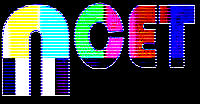 |
In this page we show some of the more important equipment NCET used (and very often struggled with). Beyond the minds and hearts of the NCET staff, cameras, monitors, video and audio tape machines, portable mixers, oscilloscopes, amplifiers, speakers and miscellaneous other devices were the core of the NCET plant. You couldn't make video without them. Three pieces of creative gear were, however, so central and crucial to NCET's artistic output and reputation that they will be shown here, but have also been given their own pages. These were Stephen Beck's Direct Video Synthesizer, the Buchlabox music synthesizer and the Templeton Video Mixer. |
|
| |
| |
|
|
| |
 |
 |
 |
 |
 |
|
| |
|
This is the Ampex 7000 - Ampex' first 1" videotape machine. It was a beast, needing to be tweaked every time it was used.
|
|
|
| |
 |
 |
 |
 |
The Sony 2110 1" video tape recorder. This machine was virtually bullet-proof; it hardly ever needed adjustment. The picture was a bit noisier than that of the Ampex machine, but it was DEPENDABLE.
|
|
 |
|
| |
| |
|
 |
|
|
| |
This was the Sony Umatic cassette recorder. We purchased 3 or 4 of the first models. They recorded on 3/4" tape, were very stable, and produced a picture at least the equal of the earlier 1" machines.
|
|
 |
 |
 |
 |
 |
| |
The Sony Portapak - it was black and white, recorded on 1/2" reel-to-reel tapes, and yielded a rather poor signal, but it was the only camera we had which could be taken out on location. The model was not part of the kit.
|
|
| |
 |
|
This is the small Sony color camera. The color was not always true but it did make pictures. We had one of these. We also had two small black and white Sony cameras for use in the studio, but no pictures of them seem to be available.
|
 |
 |
 |
 |
 |
| |
We had several of these Trinitron TV sets which were modified to work as monitors. They were very fine workhorses. They never broke down, and they didn't "hook" at the top of the picture, as did almost any other monitors we tried. The "hooking" was an intermittent horizontal displacement caused by the relative instability inherent in small format videotape playback of that period.
 |
 |
 |
And here is one of the most important devices used in making video. We used oscilloscopes similar to this one, and it was the only way one had of ensuring that the image stayed within the proper technical limits. Monitors were often misadjusted, and correcting the monitor image by 'eyeballing' it was still fairly imprecise. The oscilloscope, however, never lied.
|
|
|
| |
|
 |
|
|
| |
Stephen Beck and his Direct Video Synthesizer.
|
|
| |
|
 |
|
|
| |
Warner Jepson programming the Buchla Box audio synthesizer
|
|
| |
|
 |
|
|
| |
The Templeton Mixer
Unfortunately no photos seem to exist of the entire mixer as it was used at NCET. This is the colorizer module, built for Larry Templeton by Rick Davis. To see more module photographs visit the Templeton Mixer page. Or, to read Larry's original description of the modules, which he wrote for Vista Systems, his own company, through which he intended to market them, consult: Vista Systems.PDF (Adobe Acrobat file).
|
|
| |
The NCET Studio (a very few photos) |
|
| |
|
|
|
|
|
|

